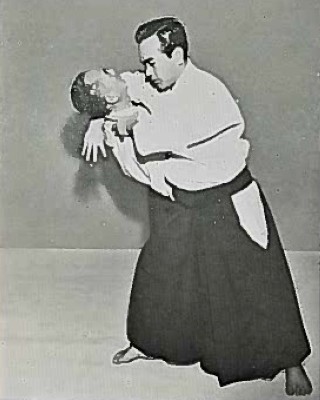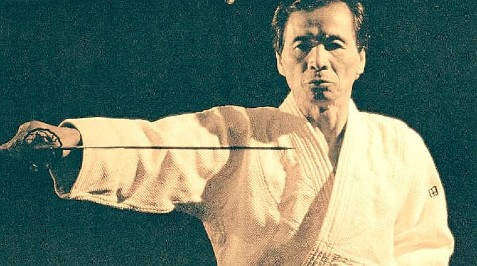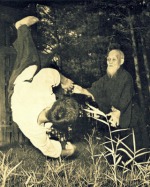The Five Main Styles of Aikido
Talk the Talk
The word aikido is a combination of three Japanese words;
Ai - Meaning Harmony or Unifying
Ki - Meaning Spirit or Life Force
Do - Meaning the Path or Way.
The meaning of the word Aikido can therefore be translated as the Way of Harmonious Spirit or as the Way of Unifying (with) Life Energy.
Walk the Walk
Koichi Tohei was instrumental in the development and spread of the martial art, both in Aikikai aikido and in Shinshin
Toitsu aikido, which he founded himself.
He did this by travelling the world teaching established martial artists and new students alike, while also teaching the concepts of
internal energy and healing to non-martial artists including athletes, sportsmen, artists and corporate directors.
His legacy continues through several books that he penned
that teach aikido techniques and philosophy that have been translated into the major Western languages and are still bestselling martial arts texts today.

The Japanese martial art aikido was developed by Morihei Ueshiba in the first half of the twentieth century both as a method of self-defence and as a way of building character and moral fibre in its practitioners. By the 1950s, some of Ueshiba’s best students were responsible for the growth and spread of the art and today, the most popular aikido styles are:
- Aikikai Aikido
- Shinshin Toitsu Aikido
- Yoshinkan Aikido
- Tomiki Aikido
- Yoseikan Aikido
While there are many other styles practised throughout the world, they can all trace their roots back to one or more of these systems and in turn, these aikido styles have all evolved from Morihei Ueshiba's school that was known as the Kobukan Dojo.
Aikikai Aikido
The Aikikai aikido School is a direct continuation of Ueshiba’s own school, and in this aikido style, there is less emphasis on the fighting side of the art and more focus on developing its practitioners as well-rounded, productive members of society. The initial success and spread of Aikikai aikido was largely down to Koichi Tohei (pictured above), a student of Ueshiba who frequently travelled to America to teach there.
However, when Ueshiba died in 1969, his third son Kisshomaru became the Doshu (leader of the way) leading to Tohei’s departure from the style a few years later. Kisshomaru Ueshiba is credited with implementing administrative protocols and with streamlining and simplifying the curriculum of Aikikai aikido which has helped the number of students who practice the style steadily grow in the decades following his appointment.
Shinshin Toitsu Aikido
Koichi Tohei left Aikikai aikido in 1974, retiring as the Chief Instructor due to philosophical differences between himself and Kisshomaru Ueshiba. In the same year, he established Shinshin Toitsu aikido which has an emphasis on the use of internal energy, so much so that it is often referred to as the Ki Society.
As well as teaching the use of Ki within the aikido techniques, Shinshin Toitsu also incorporates internal energy healing techniques into its syllabus through Kiatsuho, which Tohei founded in 1980. Koichi Tohei retired from teaching in 2007, being succeeded by his son Shinichi Tohei as head of the organisation who continued to teach and spread his father’s aikido style all over the world.
Yoshinkan Aikido
Yoshinkan aikido is considered to be the second largest of the styles after Aikikai. It was founded by Gozo Shioda in the early 1950s and is known for its frequent use of jujitsu-like techniques which are used to subdue would-be attackers. It is a non-competitive art which has a heavy emphasis on basic aikido techniques and a philosophy of cooperation and respect for all human life. In order to spread his version of the art, Shioda wrote several books on the subject and occasionally travelled abroad to teach students in the West.
The International Yoshinkan Aikido Federation (IYAF) was founded by Shioda in 1990 to promote the development of the style worldwide and a year later, he created an intensive eleven-month international instructor’s course to help maintain the high standards expected while his style of aikido grew.
After Gozo Shioda died in 1994, his eldest son Tetsutoro took over his role and today there are over ninety schools in Japan and Yoshinkan aikido is also taught to riot police in
Tokyo.
Tomiki Aikido
This style of aikido was founded by Kenji Tomiki, a judo expert and one of the top students of its founder, Jigoro Kano. In 1926, Morihei Ueshiba met with Kano to demonstrate his new art and the judo master was so impressed he urged him to take Tomiki on as a student.
His philosophy on martial arts was, as a result, heavily influenced by both Ueshiba and Kano so not surprisingly Tomiki aikido attempts to blend the competitiveness of judo with the spiritual serenity of aikido.
Drawing on his knowledge, he devised a series of techniques that permitted aikido to be practised as a sport with open competition to allow his students to have an objective way to measure their development.
This take on the martial art was largely rejected by the other aikido schools as it went against some of the teachings of Ueshiba, however, Tomiki aikido has continued to grow and competitions within the art are now held all over the world.
Yoseikan Aikido
Yoseikan aikido was established by Minoru Mochizuki (pictured below) in 1931 who like Kenji Tomiki, was an early student of both Morihei Ueshiba and Jigoro Kano. He was also an expert in Katori Shinto-ryu sword techniques and karate, and developed his style by selecting the best elements of the arts he had studied as he believed a good fighter should learn several disciplines to be able to cope with any type of attack.
Mochizuki is thought to have been the first person to teach aikido outside of Japan when he spent two years in France from 1951 teaching both judo and aikido. In 1957 he sent his son Hiroo Shihan to continue his work in France where Yoseikan aikido still has a large following today, as well as being practised in many other countries all over the world.
Written by Andrew Griffiths – Last updated 04/06/2023. If you like
what you see, consider following the History of Fighting on social media.
Further Reading:
History of Tomiki Aikido. [Internet]. 2019. Tomiki.org. Available From:
https://tomiki.org/tomiki-aikido/history [Accessed July 18, 2020].
Soshu Koichi Tohei Sensei. [Internet]. 2018. Shinshin Toitsu Aikido. Available From: https://ki-society.com/about/ [Accessed July 18, 2020].
The Different Styles of Aikido. [Internet]. 2013. Whitewingsaikido.org.uk. Available From: http://www.whitewingsaikido.org.uk/aikido/style [Accessed July 18, 2020].
What is Aikido? [Internet]. 2019. Mid-West Aikido Center. Available From: http://www.midwestaikidocenter.org/what-aikido [Accessed July 18, 2020].
More Aikido History
Aikido History Home
A look at the formation of the Japanese martial art of aikido and how it was conceptualised, created and developed by O’ Sensei Morihei Ueshiba. Aikido
techniques are unique in world martial arts as they are designed to subdue opponents by using their own force against them meaning aikido is an effective
self-defence that usually does not cause harm to others.
The images on this site are believed to be in the public domain, however, if any mistakes have been made and your copyright or intellectual rights have been breeched, please contact andrew@articlesonhistory.com.


